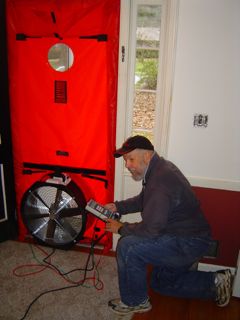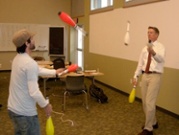A Day in the Life of a HERS Provider

 My company is a HERS rating provider, and there are a lot of duties and responsibilities that go along with that. This morning, Chris and I are heading out for a three day trip to Hilton Head and Charleston, South Carolina to wrap up the certification process for four of our home energy raters. That is, they’ll all be going through what I call the probationary field test.
My company is a HERS rating provider, and there are a lot of duties and responsibilities that go along with that. This morning, Chris and I are heading out for a three day trip to Hilton Head and Charleston, South Carolina to wrap up the certification process for four of our home energy raters. That is, they’ll all be going through what I call the probationary field test.
My company is a HERS rating provider, and there are a lot of duties and responsibilities that go along with that. This morning, Chris and I are heading out for a three day trip to Hilton Head and Charleston, South Carolina to wrap up the certification process for four of our home energy raters. That is, they’ll all be going through what I call the probationary field test.
When someone who has completed a HERS rater class signs up with Energy Vanguard Energy Ratings to get their certification, they have to complete three important tasks:
- 3 probationary ratings (1 from plans and 2 from existing homes)
- 5 practice Blower Door & Duct Blaster tests
- Probationary field test
RESNET requires only the first, but I want to make sure that our raters have more than the minimum background before I certify them to go out and do energy ratings on homes. Most raters go through one of the many one-week HERS rater training courses, and one week is simply not enough time for raters to learn all they need to know.
In fact, last week we got together with 9 of our raters to work on the probationary ratings, mainly the one from plans, which is from the house that I built and is pretty hard. At that meeting, one of the raters remarked, “I had no idea that getting through the class would be the easier part.” There’s a lot to learn if you’re going to be a rater.
Anyway, Chris and I are heading out this morning for 4 field tests, and I just wanted to talk a little about what we look for there. Whether a home energy rating is for a new home or an existing home, the rater has to go out to the house and get a lot of data, so what we’re mainly looking for in the field test is that they know and can do the following:
- Measure the house and find the conditioned floor area, volume, and square footage of the building envelope
- Look at a house and, for rating purposes, define where the building envelope is. In many existing homes, the building envelope is poorly defined, so this can be a challenge.
- Put a grade (I, II, or III) on the quality of installation of the insulation
- Find the information necessary to determine the efficiencies and capacities of the mechanical equipment
- Demonstrate proficiency in pressure testing for infiltration with the Blower Door and duct leakage with the Duct Blaster (The photo at the top shows EVER rater Bruce Kitchell doing the Blower Door test during his probationary field test.)
Some raters get nervous about this, but I use the time as much as a teaching opportunity as I do to evaluate their readiness to be a certified home energy rater. My goal for EVER is to provide the best support possible to our home energy raters,  and I think we do a pretty good job of that.
and I think we do a pretty good job of that.
I have another reason to look forward to this trip. One of the raters we’ll be working with, Jamie Kaye on Hilton Head, is a juggler. When he took the HERS class in March, we spent about 15 minutes every day at lunch passing clubs, and I think we’ll get to do that again! The photo here shows us juggling in the class.
This Post Has One Comment
Comments are closed.

Nice! I look forward to the
Nice! I look forward to the field test and that 15 minutes+ of juggling time.
Best,
Jamie